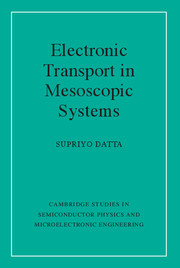Book contents
- Frontmatter
- Contents
- Acknowledgements
- A few common symbols
- Introductory remarks
- 1 Preliminary concepts
- 2 Conductance from transmission
- 3 Transmission function, S-matrix and Green's functions
- 4 Quantum Hall effect
- 5 Localization and fluctuations
- 6 Double-barrier tunneling
- 7 Optical analogies
- 8 Non-equilibrium Green's function formalism
- Concluding remarks
- Solutions to exercises
- Index
4 - Quantum Hall effect
Published online by Cambridge University Press: 05 June 2013
- Frontmatter
- Contents
- Acknowledgements
- A few common symbols
- Introductory remarks
- 1 Preliminary concepts
- 2 Conductance from transmission
- 3 Transmission function, S-matrix and Green's functions
- 4 Quantum Hall effect
- 5 Localization and fluctuations
- 6 Double-barrier tunneling
- 7 Optical analogies
- 8 Non-equilibrium Green's function formalism
- Concluding remarks
- Solutions to exercises
- Index
Summary
One of the most significant discoveries of the 1980s is the quantum Hall effect (see K. von Klitzing, G. Dorda and M. Pepper (1980), Phys. Rev. Lett., 45, 494). Normally in solid state experiments, scattering processes introduce enough uncertainty that most results have an ‘error bar’ of plus or minus several per cent. For example, the conductance of a ballistic conductor has been shown (see Fig. 2.1.2) to be quantized in units of (h/2e2). But this is true as long as we are not bothered by deviations of a few per cent, since real conductors are usually not precisely ballistic. On the other hand, at high magnetic fields the Hall resistance has been observed to be quantized in units of (h/2e2) with an accuracy that is specified in parts per million. Indeed the accuracy of the quantum Hall effect is so impressive that the National Institute of Standards and Technology is interested in utilizing it as a resistance standard.
This impressive accuracy arises from the near complete suppression of momentum relaxation processes in the quantum Hall regime resulting in a truly ballistic conductor of incredibly high quality. Mean free paths of several millimeters have been observed. These unusually long mean free paths do not arise from any unusual purity of the samples. They arise because, at high magnetic fields, the electronic states carrying current in one direction are localized on one side of the sample while those carrying current in the other direction are localized on the other side of the sample. Due to the formation of this ‘divided highway’ there is hardly any overlap between the two groups of states and backscattering cannot take place even though impurities are present.
- Type
- Chapter
- Information
- Electronic Transport in Mesoscopic Systems , pp. 175 - 195Publisher: Cambridge University PressPrint publication year: 1995



